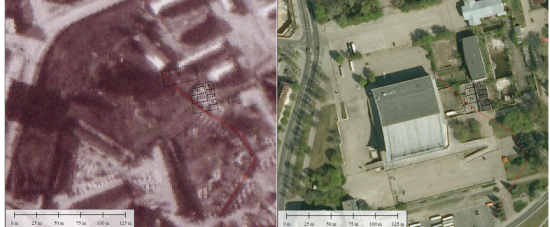PIRAMÓNT | PAPER TRAIL | OPPOSITION | CEMETERIES
◊
VILNIUS—Defending History today obtained from multiple sources here PDF copies (all with some faulty representation of Lithuanian language diacritics) of a new geophysical report by the company GeoBaltic, specialists in oil and gas exploration, on the territory of the old Jewish cemetery at Piramónt in the Šnipiškės section of modern Vilnius. The entire document is now available online, and it is anticipated in some quarters that one or more of the funded bodies tasked with preserving Jewish heritage in Europe (e.g. the US taxpayer-funded Commission for the Preservation of America’s Heritage Abroad in Washington DC and the CPJCE in London) will rapidly publish a full English translation along with their own reactions and responses.
In the meantime, in addition to posting the original PDF, we are posting one image, from page 9 of the document, which juxtaposes a 1944 aerial photo with a modern photo and superimposes a dotted red line for comparison (which however stops abruptly, though the comparison of the two photos easily makes way for its completion). It is important to note, however, that in the final 80-90 years of Russian imperial rule (early 1830s to World War I, approximately), significant parts of the cemetery were arbitrarily pilfered by the czarist authorities, with little indication of which of those areas still contains graves, especially at greater depth (given the long tradition of multiple vertical layers in centuries-old urban cemeteries). What is beyond dispute is that all disturbance at the area yields human remains at very shallow depths.
◊
It is not known whether the GeoBaltic company has been commissioned to provide a neutral scientific report without preconditions, or whether it has been retained in a partisan capacity by one of the parties to the dispute clamoring for construction of a multimillion dollar convention center, e.g. the relevant agencies of the Lithuanian government and the London based CPJCE. The following is a translation of the report’s final section:
◊
Conclusions and Recommendations
1. The ground within the scanned area is predominantly unnatural soil, i.e. it is not natural untouched ground. Looking at scanned slices, it is seen that there are various underground communications and the lack of abnormalities that are typical for natural soil (i.e. untouched ground).
2. The sole anomaly which in its dimensions and shape might be related to a plot of the cemetery, is detected in the section F2 within area ŠV. However, deeper this anomaly (down about 1.5 m) has underground communications what provide more reasons to believe this anomaly has techno-genic origin.
3. Based on the German aviation aerial photo from 1944, the Eastern border of the cemetery has been drawn on the site’s up-to-date plan map. This border line (designed this way) passes through the segments F4, F3 and G (of tested areas). (Or to put in human language: Tested section F3, F4 and G covers the area of the most recently drawn border line of the cemetery). Within section G there is no sign of abnormalities that might be related to the above mentioned boundary (of the cemetery). The border lines of differing reflective intensity (i.e. frontier of soil layers of different physical qualities) passes within section F3 and section F4. The border (of changes in soil qualities) is very close to the (recently) assumed boundary of the cemetery. However, more likely the changes in soil qualities are of technogenic origin, while the frontier there nearly overlaps with the underground communications 1 meter down in the ground.
4. If the question of setting boundaries of the cemetery remains relevant, we would recommend 3D scanning within the section PR of the cemetery, where the construction / excavation works were less intensive (see map bellow, follow the black arrow).
